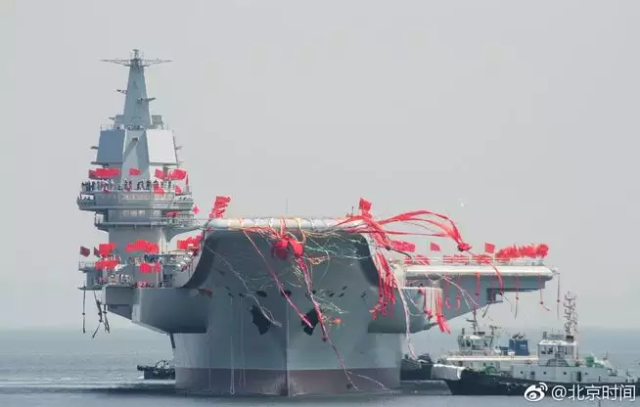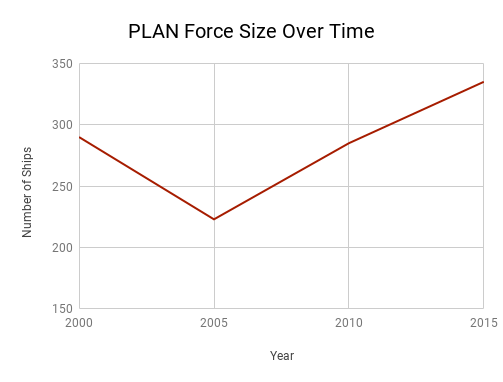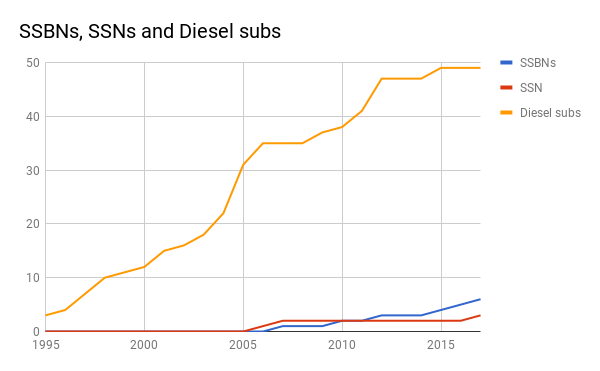
China’s Evolving Naval Force Structure: Beyond Sino-US Rivalry
Publication: China Brief Volume: 18 Issue: 9
By:

During a recent discussion with PLA analysts, one interlocutor observed to the author that American strategists are slaves of their own history. That is, in interpreting the facts on the ground Americans cannot help but look to their own history to interpret the nature of strategic threats. By this he meant that Americans necessarily see China’s naval force structure development through the lens of the US’s own rise to maritime supremacy, and imagine the PRC on an inexorable rise to naval power. While we could dismiss this as a Chinese Communist Party (CCP) talking point, it is an assertion that is worth examining, because it does contain an element of truth. A closer examination of the PLA Navy (PLAN) force structure over the past two decades reveals not an unstoppable march towards a fixed objective, but an evolving set of objectives designed to partially address a number of national security threats.
Figure 1 displays the size of the PLA’s force structure in five year increments dating back to 2000. Unquestionably the development of China’s navy has seen substantial changes; it is no longer the 1970s-level naval force that it was in the 1990s. The numbers also do not reflect the fact that the vessels are more modern, have longer range weapons systems, and have moved beyond point defense to area missile defenses. Senior Asia security analysts have expressed concern that the numbers and types of ships acquired by the PLA Navy (PLAN) reflect its evolution into a sea control navy.

Figure One: PLA Navy Force Structure, 2000-2015. Source: O’Rourke, CRS, 2017
These concerns could be borne out. At the same time, other parts of the US national security analysis community tend to rely on monocausal analysis, attributing the PLAN’s rising ship numbers solely to a deliberate pursuit of maritime dominance: at best, this is incomplete analysis.
An in-depth look at Chinese naval force structure development since the mid-1990s reveals a more complex dynamic, one that does not resemble a mad dash to assert regional dominance. Since that time, the PLAN has built three attack submarines, seven to eleven destroyers, and approximately 20 frigates, while reducing its number of amphibious ships and missile patrol craft. Compared with the Imperial Japanese Navy in the twenty year run-up to the Second World War, we are confronted with substantially different rates of force structure growth. Japan constructed nine aircraft carriers between 1922 and 1941, in addition to over 125 destroyers, twenty light cruisers and eighteen heavy cruisers.

Figure Two: PLAN Submarine Commissions (1995-2017). Source: O’Rourke, “China’s Naval Modernization: Issues for Congress”, 2017
Secondly, PLAN vessel development since the mid-1990s does not seem to reveal a force focused on acquiring the naval capabilities needed for global, or even regional dominance. Figure Two shows that the PLAN still possesses only a handful of nuclear attack submarines (SSN). Instead it has focused its attention developing and acquiring diesel submarines, tripling the number between the mid-1990s and the present. Diesel subs are arguably a platform more suited to keeping naval forces out of the region than projecting power within it. Additionally, if the Chinese leadership was intent on challenging the United States, why only three to five SSBNs? Similarly, the acquisition of underway replenishment ships (now approximately eight) did not become a focus of PLAN force structure development until the 2010s, after China embarked on sustained “out of area” counterpiracy missions.
Also, although much has been made of China’s development of its first aircraft carrier (the Liaoning), according to the memoirs of PLAN Admiral Liu Huaqing, the development of such a platform was long vetoed because of a belief that China’s external environment did not warrant such an expense. [1] It was not until 2004 that China’s expanded overseas interests prompted Hu Jintao to green-light the Liaoning (SCMP, January 19 2014). This pace of acquisition–one carrier over the course of twenty years–illustrates that China’s force structure development calculus is not prefaced on a relentless drive toward regional and global hegemony.
Third, if China’s ultimate goal during the decades prior was regional or global dominance, it would be logical to first resolve security issues closer to home, such as Taiwan, before seeking to topple the US. But the evolution of the PLAN’s force structure does not reflect a strong focus on resolving “the Taiwan question”; it possesses less than sixty amphibious capable vessels. [2] Four of these L-class ships are Landing Platform Dock (LPD) capable ships useful for long-range expeditionary missions, each capable of lifting only a battalion, and not especially useful for rapidly generating a force ashore for a blunt amphibious assault on Taiwan. Had the CCP been interested in sprinting towards domination, the first order of business, beginning in the 1990s, would have been the production of enough LSTs to give the PLAN the lift needed to conduct a landing on the wayward province. This has not turned out to be the case.
What then does the evolution of the PLAN force structure suggest about China’s long-term strategy? Although basing speculation about a country’s strategy on its military force structure is not without its hazards, evolving orders of battle leave fingerprints from which we can infer intent.
Broadly, we can describe this intent in three statements:
1) The evolution of the PLAN’s force structure the past twenty years reflects the CCP’s concern about many national security contingencies, rather than a single-minded drive for global domination.
This evolution is marked neither by a relentless pursuit of the Taiwan problem, nor a rapid push to quickly take on the US both regionally and globally. It appears designed to partially address a number of larger national security threats: coercing Taiwan; keeping the US out of China’s operational space; counter-deterrence; coastal and regional defense; protecting maritime rights; and far seas protection and out of area operations.
2) The evolution of the PLAN suggests a contingent element of force structure development.
Put differently, the CCP is uncertain of its future security environment. They are therefore willing to slowly develop their naval capabilities, reexamine mission requirements, and adjust the development of their acquisitions before proceeding forward. Case in point: China did not start to acquire an underway replenishment capability (AORs) in any significant numbers until after the requirement to sustain China’s counter-piracy operations emerged in the 2010s. Another example: The PLAN tinkered constantly with its destroyer designs until 2013, strongly suggesting that its designs changes with the shifting of maritime mission requirements. Yet another example: The PLAN’s approval for an aircraft carrier acquisition did not come until 2004, after Hu Jintao and the CCP articulated a new security doctrine known as the “New Historic Missions”.
3) The development of China’s naval force structure suggests that the CCP is attempting to balance a range of competing, overlapping and complex mission sets for the purposes of attaining larger political objectives.
This explains the acquisition of more modern L-class ships (LPDs and possibly LHDs) which can be used to exert coercive pressure on Taiwan, but are less useful in a Taiwan assault than larger numbers of modernized LSTs. These newer L-class ships can also be used to address far seas missions such as non-combatant evacuation operations, counter-piracy, humanitarian assistance, and disaster relief. This larger rationale explains the dual emphasis on both diesel-powered and nuclear-powered submarines: diesels, for the purposes of keeping the US Navy at arm’s-length; nuclear attack submarines for “out of area” operations, slowing the arrival of US Navy forces from out of theater, and potential future counter-deterrence missions (e.g. SSBN hunting).
Implications
None of the foregoing analysis should be construed to mean that the PLAN will not, in the long run, develop a blue water, power projection navy that can be used to contest American power both inside the region and out. That is a distinct possibility, if not an inevitable result. This analysis does not contradict calls for the US to refocus on shipbuilding, and develop a naval force structure sizeable enough to meet the demands of contested sea control in the Asia-Pacific and beyond.
What this analysis does suggest is that the US Navy might need to rethink the specifics of its approach to acquisition over the next few decades—perhaps an impossible task given current processes. Adherents to the idea that China and the US are entering into a period of great power competition tend to assume that US Navy’s force structure should emphasize sea control missions. However, since China appears to be “crossing the river by feeling the stones”, a mad dash to build out a US naval force structure designed entirely for contesting maritime supremacy with the Chinese might not be optimal [3].
As an example, a US force structure that emphasized sea control would most likely come at the expense of expeditionary platforms (e.g. big deck or medium-sized amphibious platforms), or smaller, more vulnerable platforms like the Littoral Combat Ship, which are focused on non-traditional missions and well suited to cooperation with Asia-Pacific partners. Ironically, since meeting the Chinese challenge appears to require flexibility, these might be some of the platforms most useful in a political wrestling match with the Chinese in the East and South China Seas in a decades-long runup to a possible US-China contest for maritime supremacy.
The preceding analysis should also inform how US naval forces are deployed to address a rising Chinese naval challenge. Since PLAN force development appears to take into account the broad political objectives of the CCP, US naval operations should be ideally designed to blunt some of the political effects of PLAN force deployment. Questions to consider include: Should greater PLAN presence in the Indian Ocean suggest an alteration of Seventh Fleet deployment patterns in the Indo-Asia Pacific Region? Which emerging US Navy operational concepts are best if PLAN force structure development is meant to realize specific CCP political objectives?
Conclusion
PLAN force structure development, as is the case with larger PRC defense and foreign policy, is posing a vexing problem for US strategists and policy makers. The PRC has grown its force in ways that make it difficult for competitors to formulate a proper strategic response. Rising to the challenge on the US’s part will require a degree of self-reflection. It will require the US to rethink its ship acquisition process, how it formulates maritime strategy, its employment strategies in the Indo-Pacific, and its contingency planning. Although difficult, it is not a challenge from which we can afford to shrink.
Dr. Christopher Yung is the Donald Bren Chair of Non-Western Strategic Thought and Director of East Asian Studies at the US Marine Corp University. He conducts research on such topics as Chinese expeditionary warfare capabilities and doctrine, China’s emerging foreign and defense policy, and China’s emerging maritime capabilities and strategies.
Notes
[1] This anecdote can be found in Liu Huaqing Hui Yilu (流华清回忆录), published in 2004 by the China People’s Liberation Army Publishing House (人民解放军出版社).
[2] These and subsequent quoted ship numbers are drawn from PLAN Submarine Commissions (1995-2017). Source: O’Rourke, “China’s Naval Modernization: Issues for Congress”, 2017.
[3] “Crossing the river by feeling the stones” (摸着石头过河) was a proverb coined by Deng Xiaoping to describe how the PRC works towards its objectives over time, shifting plans as the political and security environment changes.




